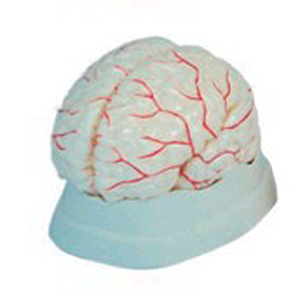

Article tag: Cerebral artery model| Cerebral Anatomy Model| BIX-A1051|
Therefore, it can be said that the cerebral artery model not only has the potential to become an indispensable teaching tool in neurological education, in fact, it has begun to be widely used in many medical education and has proved its great value.
...In modern medical education, neurology, as a very complex and highly accurate subject, requires students not only to have a solid theoretical knowledge, but also to have a keen observation and operation ability in practice. Especially in the field of neurology, the anatomy, function and lesion identification of cerebral vessels are crucial for early diagnosis and treatment. As an innovative teaching tool, cerebral artery model is playing an important role in neurology education. So, can it really become an indispensable teaching tool in neurological education?
1. Provide a highly accurate anatomical learning platform

The cerebral artery model can accurately reconstruct the cerebral artery and its distribution. For medical students, especially those majoring in neurology, this can help them intuitively understand the complex cerebrovascular system. Traditional anatomical maps and 2D images may be difficult to provide a complete sense of space, but 3D cerebral artery model can help students better grasp the three-dimensional structure of cerebral vessels.
Some data suggest that students taught using the cerebral artery model generally score higher on anatomy exams than students who rely solely on books or images. This indicates that the visual and operational advantages of the model enable students to grasp the anatomy and structure of cerebral arteries more comprehensively.
2. Improve the practical ability of clinical skills
The cerebral artery model can not only help students understand the anatomical structure, but also improve their practical operation ability by simulating the clinical situation. For example, in the operation of cerebral artery intubation and angiography, students can practice repeatedly through cerebral artery model to reduce errors in operation.
Through simulated clinical operations, students are able to familiarize themselves with the operation process without patients, reducing medical errors or unnecessary operational risks caused by unskilled technology. The effect of this practical training was validated in a survey: more than 90% of respondents reported a significant increase in their confidence and skill levels after operational training using the cerebral artery model.
3. Enhance the recognition and diagnosis of disease lesions
Cerebral artery model can also be used to simulate a variety of cerebrovascular diseases, such as aneurysm, thrombosis, arteriosclerosis and so on. By simulating these lesions, students not only learn how to identify the anatomy of the lesions, but also gain an in-depth understanding of the hemodynamic changes and their clinical significance.
For example, the cerebral artery model can simulate different types of aneurysms, and students can observe the effects of different lesions on cerebral blood flow through the operation of the model. This simulation can not only help students improve their ability to diagnose cerebrovascular diseases, but also enhance their understanding of the development process of lesions.
4. Enhance interdisciplinary cooperation and communication skills
The use of cerebral artery models is not limited to anatomy teaching, but can also be an important part of a multidisciplinary curriculum. For example, students in neurosurgery, radiology, anesthesiology and other disciplines can use the model to conduct interdisciplinary joint learning. The precise structure of the model allows students from different majors to understand each other's work, promoting communication and cooperation.
5. Data support and practical effect
A number of studies and experimental data show that the use of cerebral artery model training can significantly improve the learning effect and skill mastery. In a survey involving multiple medical schools, students who participated in the use of the cerebral artery model demonstrated higher operational proficiency and fewer diagnostic errors in actual clinical work. It also shows that cerebral artery model is not only a teaching tool, but also an effective way to improve the practical clinical ability of medical students.
Sum up
As an important tool in neurology education, cerebral artery model plays a significant role in improving students' clinical operation skills, anatomical understanding ability, and disease diagnosis ability. In the transition from theory to practice, especially involving complex cerebrovascular structures and diseases, the cerebral artery model is undoubtedly an indispensable teaching tool. With the progress of technology and the change of teaching mode, this model will play a more important role in neurological education in the future.
Therefore, it can be said that the cerebral artery model not only has the potential to become an indispensable teaching tool in neurological education, in fact, it has begun to be widely used in many medical education and has proved its great value.